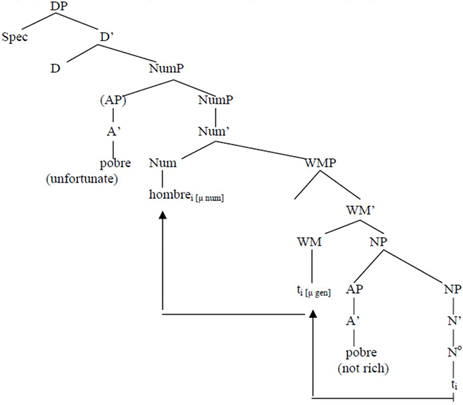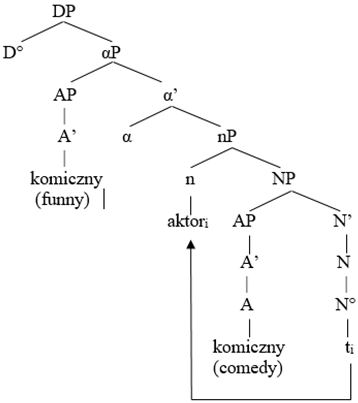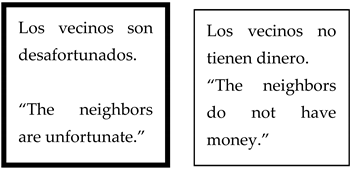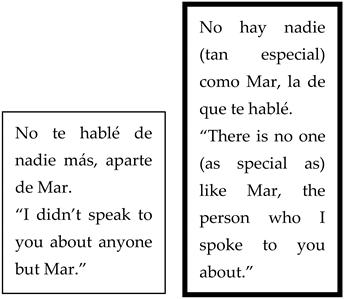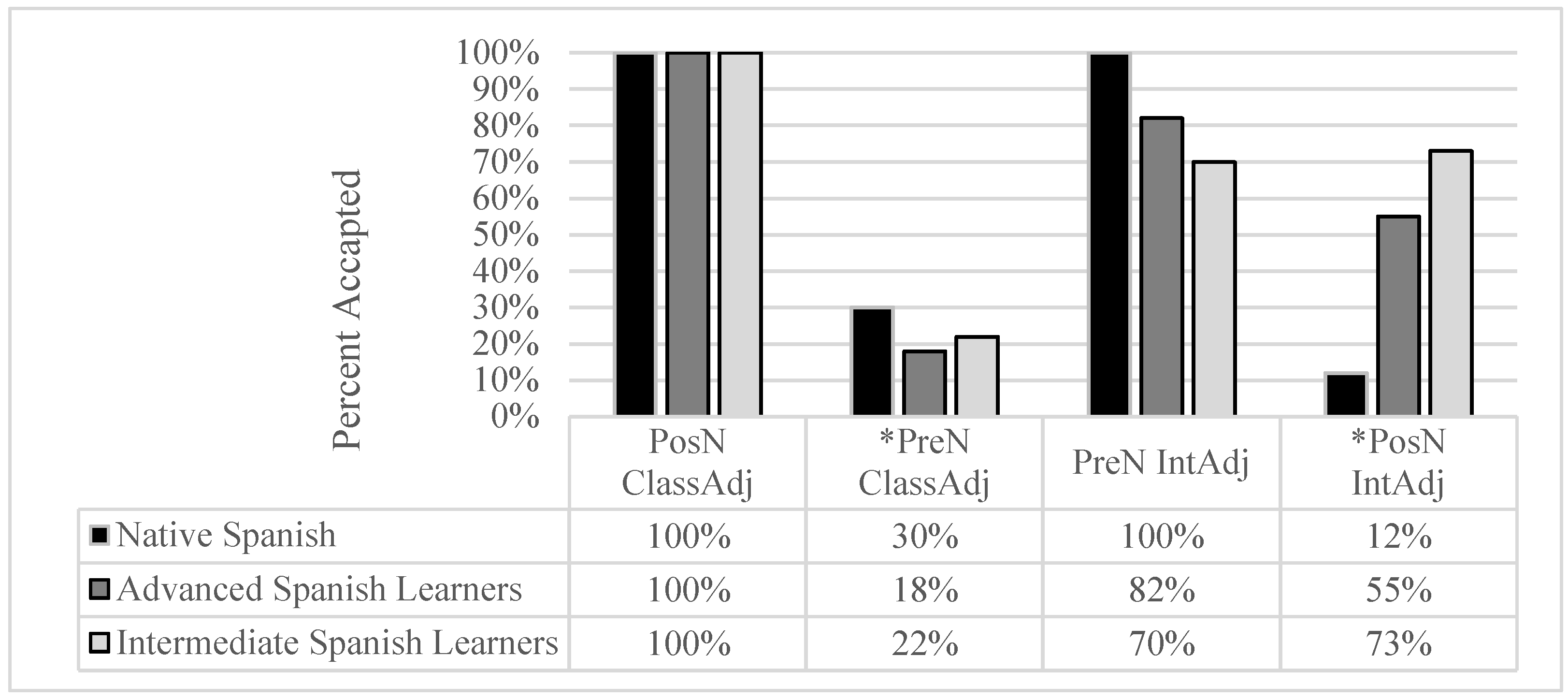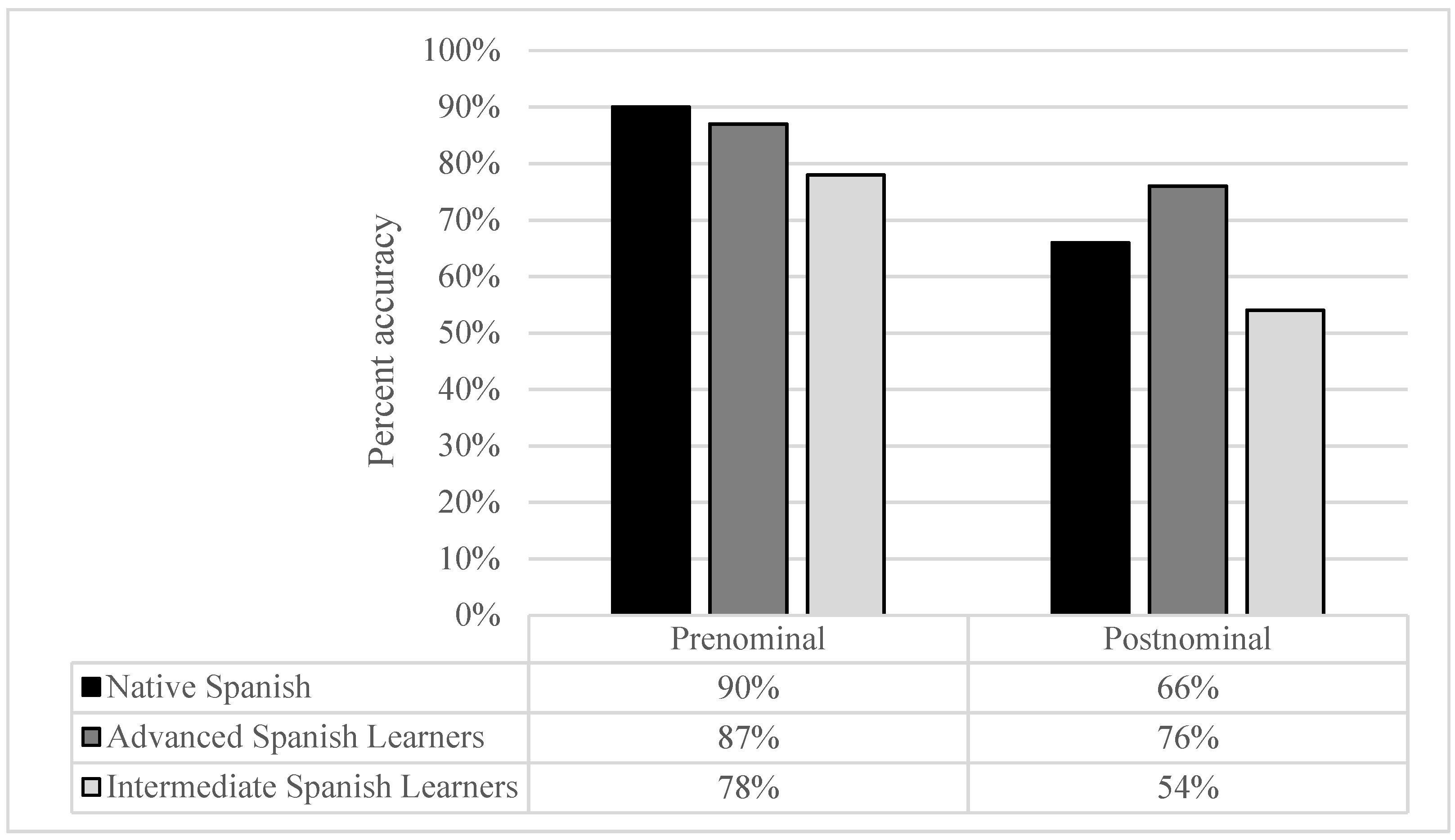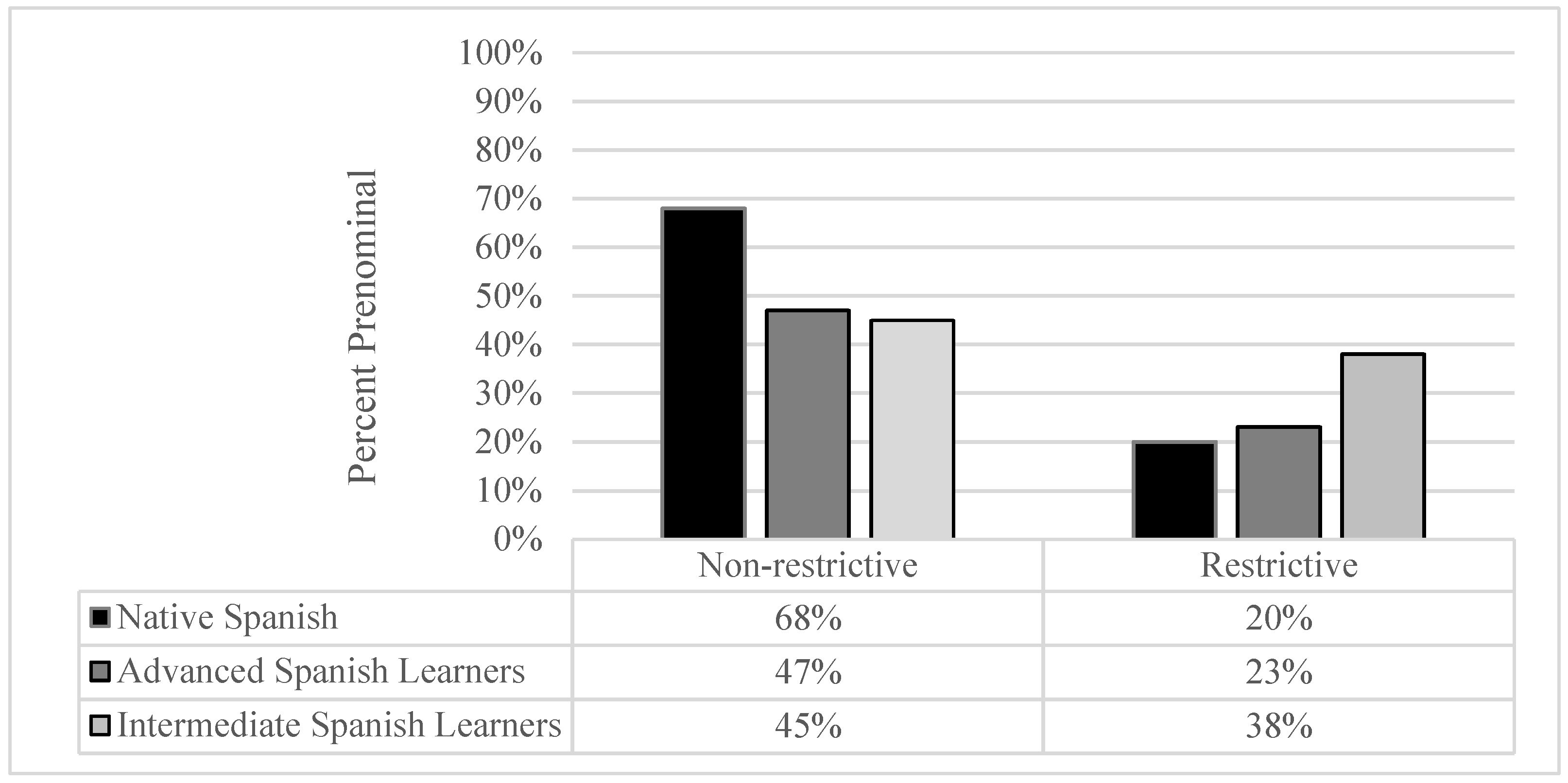1. Introduction
Functionalist and formal approaches have contributed to our understanding of adjectives in Spanish, with the former focusing more on distribution and the latter on interpretation. Though fewer in number, variationist studies on adjective position reveal that postnominal adjectives are more frequent in spoken and written Spanish (
Centeno-Pulido 2012), and that the relative syllabic weight of the adjective (
File-Muriel 2006), style of speech (
Hoff 2014), and lexical frequency (
Kanwit and Terán 2020) influence placement of alternating adjectives in native Spanish, which constitutes some of the input L2 learners receive. Generative interest in microvariation (
Baker 2008;
Kayne 2005) has surfaced more frequently in recent formal acquisition studies, and for fruitful reasons. Microvariation places differences among languages and dialects in the lexicon (
Biberauer et al. 2010;
Borer 1984;
Chomsky 2008). As described below, the field of Second Language Acquisition (SLA) is steadily moving from larger-scale questions (e.g., new feature acquisition in post-pubescent learners) to narrower questions affecting language acquisition. Purposefully including language pairings that vary in micro, as opposed to macro, ways facilitates this goal, and necessarily requires the examination of a wide array of language combinations. In addition to benefiting our general understanding of linguistic typologies, seeking a more precise understanding of them can be applied to language acquisition scenarios, including differences between the native (L1) and second (L2) language, the acquisition task faced by learners, how input may be parsed, and explanations of (non-)convergence. Ultimately, more encompassing comparisons across varying language pairings increase the explanatory adequacy of the field’s theorizing. As stated by
Judy and Perpiñán (
2015) regarding non-primary language acquisition:
[i]t is only through a systematic comparison of different language combinations that we can tease apart what comes from first language transfer (whether facilitative or non-facilitative) and what comes from other sources such as Universal Grammar, frequency of input, or general cognition.
(p. 2)
The first formal studies to examine adult acquisition of the syntactic and syntax–semantic distribution of adjectives focused mostly on Spanish and French
1 and were largely couched in terms of the theoretical debate surrounding post-pubescent acquisition of properties/features absent in the L1. Non-convergence accounts, whether due to representational differences (e.g.,
Hawkins and Chan 1997) or interface difficulties (
Sorace and Filiaci 2006), predict that adult L2 learners will be non-native-like in all domains
2. Conversely, convergence accounts assume, generally, that acquisition is possible given access to linguistic input that would trigger acquisition (
Manzini and Wexler 1987;
Schwartz and Sprouse 1996). Given this theoretical context, early studies logically examined language pairings that differed significantly. While earlier studies (
Bruhn de Garavito and White 2002;
Parodi et al. 1997) examined language production, a second wave of studies focused on interpretive knowledge of adjectival placement said to result from acquisition of underlying syntax. For example,
Judy et al. (
2008) found that intermediate L1 English, L2 Spanish speakers showed evidence of new DP
phi-features, but non-native-like interpretations of adjectival placement. Their advanced proficiency peers, however, performed more in line with native speakers, highlighting proficiency as an important factor. Similar findings obtained in
Rothman et al. (
2010), although some intermediate L2 Spanish speakers demonstrated knowledge of adjectival syntax and interpretation. For French,
Gess and Herschensohn (
2001) reported that L1 English, L2 French learners showed knowledge of nominal gender features not instantiated in the L1, but fell short of native-like knowledge of adjectival placement.
Anderson (
2008) also reported L1 English, L2 French learner convergence on interpretive constraints related to French noun-raising: result and process nominals, and unique- and non-unique-denoting adjectives. Like the aforementioned studies, Anderson reported that true acquisition is demonstrated via syntax–semantic knowledge.
Bruhn de Garavito and White (
2002) is the first known adjective study to explicitly examine typologically similar languages, L1 French and L2 Spanish. Since the study examined elicited production data alone, the nature of the participants’ underlying grammar is unclear under a generative perspective. Still, the authors reported that adjectival word order was unproblematic for the participants, which is unsurprising “since both the L1 French and the L2 Spanish have N Adj word order” (2000, p. 173).
Androutsopoulou et al. (
2008) examined L1 French, L2 Spanish convergence on evaluative (i.e., qualifying) adjectives. French and Spanish share similar adjective distribution overall and each allows (some) evaluative adjectives to appear pre- and postnominally. Nevertheless, French permits fewer evaluative adjectives prenominally than Spanish, a property the authors claim is tied to the Focus/Degree feature of evaluative adjectives. The partial overlap between the languages creates a less straightforward acquisition task than that faced by L1 English learners of other studies. Nonetheless, some participants showed native-like intuitions. This study is especially informative, not only for larger-scale questions regarding adult transfer and UG-accessibility, but particularly because it highlights the importance of considering micro-differences between closely related and similar languages.
Follow-up studies in Spanish examined participants whose L1s display varying degrees of overlap with Spanish adjectives under the same methodology.
Guijarro-Fuentes et al. (
2009) tested L1 transfer effects by comparing L1 English with L1 Italian participants, while
Rothman et al. (
2009) included a Germanic group comprising English and German L1 speakers and an L1 Italian group. Results showed that intermediate and advanced L1 Italian participants provided direct (
phi-features) and indirect (adjectival interpretation) evidence of underlying Spanish values. However, only advanced L1 English participants demonstrated evidence of acquisition of new functional features and subsequent knowledge of the semantics that fall out from it, a difference that points to the deterministic nature of L1 transfer.
These studies informed an important domain of inquiry (DP acquisition), contributed to relevant SLA debates, and advanced the field’s research agenda. Nevertheless, two final aspects merit discussion as they bear directly on the current study’s design. First,
Androutsopoulou et al. (
2008) is the first and only known study to explicitly examine and compare adjective type in L2 Spanish speakers (or French, for that matter). While some previous experiments on L2 acquisition of Spanish included alternating qualifying adjectives in the semantic tasks, and
Judy et al. (
2008) included strictly prenominal (i.e., intensional) and strictly postnominal (i.e., classifying) adjectives in the syntax task, the value in Androutsopoulou et al.’s approach is that consideration of adjective type and its relationship to adjective position allows us to disentangle specific ways L1 values can influence subsequent language acquisition. This approach can also reveal important insights regarding acquisition that may be masked if only adjective position is considered. Furthermore,
Rothman et al. (
2009) failed to exploit, perhaps due to few L1 German participants, a potentially illustrative component of the languages examined therein. German and English have similar nominal word order and lack noun-raising, while German and Spanish both have rich nominal agreement systems including gender and number. Teasing apart subtle differences between English and German may have proven informative, as in
Liceras and Alba de la Fuente (
2015). Upon reviewing several properties examined in the L1 French, L2 Spanish acquisition literature, the authors argue that, although both are Romance languages, Spanish and French display subtle differences best defined via a feature analysis, as compared to a parametric one (2015, p. 352).
Due to the nature of its fundamental aim—to determine if convergence on the syntactic and semantic distribution is possible for L1 Polish learners of Spanish, the current study adopts a generative approach. Its contributions include that it is the first known study examining L1 Polish speakers’ knowledge of adjectival distribution in Spanish. In fact, few studies explore Spanish in the context of Polish, two typologically dissimilar languages. The property itself is also of experimental and theoretical value precisely because adjectival distribution in Spanish is considered a
poverty-of-the-stimulus property (
Anderson 2007;
Chomsky 1980). The full gamut of semantic differences obtained from adjective position are not deducible from the input alone, nor are they taught
3; rather, knowledge of them purportedly falls out from acquisition of gender and number features readily available in the input. Furthermore, while some similarities exist between Polish and Spanish DPs, L1 transfer alone cannot result in native-like convergence, thus creating a real acquisition task. Finally, as
Androutsopoulou et al. (
2008) highlighted, this study provides a more fine-grained analysis of adjectival convergence via separate treatment of three adjective types—intensional, classifying, and qualifying—contributing to our understanding of microvariation across languages.
3. Research Questions and Predictions
Based on the acquisition task, the following research question is examined:
It is assumed that a language learner of any background can come to acquire a native-like underlying grammar provided they are exposed to sufficient meaningful input and that said input triggers grammatical restructuring, via parsing failures, where necessary (
Manzini and Wexler 1987). Following
Schwartz and Sprouse (
1996), full transfer of the Polish DP is assumed for the initial state of Spanish learning. Full transfer of the Polish DP provides the Spanish learner with a DP structure that correctly places intensional and (largely) classifying adjectives since these occupy the same position in both languages. Nonetheless, a parsing failure is required for convergence on qualifying adjectives since they appear in different positions in Spanish and Polish. When Polish speakers encounter Spanish qualifying adjectives in postnominal position, their Polish grammar cannot accommodate the structure, causing a parsing failure. It is assumed that the input Spanish learners are exposed to contains instances of postnominal qualifying adjectives as they occur frequently, and especially because explicit instruction on this difference is typically provided for classroom learners.
Due to the unique nature of each adjective type examined, the predictions for convergence are presented individually. First, intensional adjectives are predicted to be correctly accepted in their prenominal position, since they are prenominal in both languages. Similarly, postnominal intensional adjectives are predicted to be correctly rejected as they are ungrammatical in both Spanish and Polish. Second, postnominal classifying adjectives are predicted to be correctly accepted since they appear postnominally in both languages, obligatorily in Spanish and alternatingly in Polish. Nonetheless, prenominal classifying adjectives are predicted to be incorrectly accepted precisely because no positive evidence is present in the input that would trigger restructuring
11. Finally, for alternating qualifying adjectives (e.g.,
cómico “comical/comedy”), both pre- and postnominal alternating qualifying adjectives are predicted to be correctly accepted since the input provides positive evidence that grammatical restructuring is necessary (i.e., the presence of an alternating qualifying adjective in postnominal position, which cannot be parsed in Polish).
Table 2 summarizes the predictions for each adjective type.
Summarizing, distinct predictions obtain for each adjective type and position given differences between Polish and Spanish. Importantly, while convergence on the Spanish DP is predicted to be largely possible, with the two remnants from Polish described above, previous research has shown that even in typologically similar languages, L2 learners encounter difficulties mapping features present in their grammar onto new morphological forms (e.g.,
Lardiere 2007;
Prévost and White 2000). Consequently, it is essential to not simply consider feature acquisition or DP word order, but rather to also examine interpretation.
5. Results
5.1. GJCT Results
The first two columns in
Figure 1 display the percent of classifying adjectives accepted in each position. While the participant groups correctly accepted all grammatical classifying adjectives, different acceptance rates are seen for ungrammatical classifying adjectives. The latter two columns display the percent of intensional adjectives accepted in each position. Here, only NSs perform at ceiling, with the learner groups showing gradient acceptance as a function of proficiency. A similar pattern is observed for the ungrammatical postnominal adjectives.
The GJCT data were analyzed via a binary logistic mixed model with pairwise contrasts and Sidak corrections applied as indicated by the model. Random intercepts were included for participant and trial, while the fixed effects in the final model included group (NSs, AdvSLs, or IntSLs), adjective type (classifying or intensional), and position (pre- or postnominal), the two-way interactions group*adjective type and group*position, and the three-way interaction group*adjective type*position. No main effects were found for group (
F(2,1028) 0.000,
p < 1.000), adjective type (
F(1,1028) 0.001,
p = 0.974), or position (
F(1,1028) 0.002,
p = 0.968). No two-way interactions were found between group*adjective type (
F(2,1028) 0.000,
p < 1.000) and group*position (
F(2,1028) 0.001,
p = 0.999). Nonetheless, the three-way interaction for group*adjective type*position was significant (
F(3,1028) 18.401,
p < 0.000). Model estimates of the probability of acceptance, along with the confidence intervals, are provided in
Table 4.
Planned Sidak comparisons revealed no statistically significant differences between any of the groups regarding their acceptance of classifying adjectives overall or of intensional adjectives overall. However, IntSLs and AdvSLs accepted statistically significantly more intensional adjectives overall than classifying adjectives (p = 0.017; p = 0.030, respectively), while no statistically significant difference obtained for NSs. For the group*position interaction, no statistically significant difference obtained between the groups regarding their acceptance of postnominal adjectives overall; nonetheless, both IntSLs and AdvSLs accepted statistically significantly fewer prenominal adjectives than NSs (p < 0.001; p = 0.001, respectively). The IntSLs and AdvSLs accepted statistically significantly more postnominal adjectives overall than prenominal adjectives (p < 0.001; p < 0.001, respectively), while no statistically significant difference obtained for NSs.
Lastly, for the group*adjective type*position interaction, no statistically significant differences obtained between NSs and either learner group regarding their accuracy on pre- or postnominal classifying adjectives. However, NSs accepted statistically significantly more grammatical prenominal intensional adjectives than AdvSLs (Odds Ratios (OR)
14 = 13.78,
p = 0.015) and fewer ungrammatical postnominal intensional adjectives (OR = 0.488,
p < 0.001). Likewise, NSs accepted statistically significantly more grammatical prenominal intensional adjectives than IntSLs (OR = 24.59,
p = 0.001) and fewer ungrammatical postnominal intensional adjectives (OR = 0.272,
p < 0.001). The IntSLs accepted statistically significantly more ungrammatical postnominal intensional adjectives than did the AdvSLs (OR = 1.79,
p = 0.041). No differences obtained between the learner groups for the grammatical prenominal intensional adjectives. Statistically significant differences obtained for each groups’ treatment of adjective type according to position; each group accepted statistically significantly more prenominal intensional adjectives than prenominal classifying adjectives (
p < 0.001), as well as statistically significantly more postnominal classifying adjectives than postnominal intensional adjectives (
p < 0.001). Finally, NSs and AdvSLs accepted statistically significantly more classifying adjectives in postnominal position than in prenominal position (
p < 0.001), as well as statistically significantly more intensional adjectives in prenominal position than in postnominal position (
p < 0.001). The Intermediate Learner group also accepted statistically significantly more classifying adjectives in postnominal position than in prenominal position (
p < 0.001), but did not make a statistically significant difference in their acceptance of pre- and postnominal intensional adjectives.
5.2. SIT Results
Figure 2 displays the percent accuracy of pre- and postnominal meaning-changing adjectives employed in the SIT. As compared to the GJCT and some previous studies examining adjectival interpretation in Spanish (
Guijarro-Fuentes et al. 2009;
Rothman 2008;
Rothman et al. 2009), a lower accuracy rate is evidenced by NSs on postnominal tokens. Still, similar rates were found for native Argentine Spanish speakers (
Judy 2018) as well as native French speakers (
Anderson 2007). AdvSL interpretations were more native-like than those of the IntSLs for postnominal adjectives.
The SIT data were submitted to a binary logistic mixed model with pairwise contrasts and Sidak corrections applied as indicated by the model. Random intercepts were included for participant and trial, while the fixed effects in the final model included group (NSs, AdvSLs, or IntSLs), position (pre- or postnominal), percent daily Spanish, and the two-way interaction group*position. A main effect was found for group (
F(2,621) 7.804,
p < 0.001), but not for position (
F(1,621) 1.900,
p = 0.169) or percent daily Spanish (
F(1,621) 0.083,
p = 0.774)). No interaction was found between group*position (
F(2,621) 1.855,
p = 0.157). Model estimates of the probability of accuracy, along with the confidence intervals, are provided in
Table 5.
Planned Sidak comparisons (α = 0.05) revealed no statistically significant differences between NSs and either learner groups regarding their responses to pre- or postnominal adjectives. However, AdvSLs performed statistically better on the postnominal adjectives than IntSLs (OR = 1.67, p = 0.004). Finally, no participant group made a statistically significant distinction between pre- and postnominal adjectives, indicating equal performance on both positions.
5.3. SCT Results
Figure 315 displays the percent prenominal placement of the alternating qualifying adjectives employed in the SCT. While a higher percentage of prenominal placement for all participant groups is seen for the restrictive condition, participants prefer postnominal placement for the restrictive condition, a finding also reported in previous studies (
Guijarro-Fuentes et al. 2009;
Judy 2018;
Rothman et al. 2009).
The data were submitted to a generalized linear mixed model with pairwise contrasts and Sidak corrections applied as indicated by the model. Random intercepts were included for participant and trial, while the fixed effects in the final model included group (NSs, AdvSLs, or IntSLs) and condition (restrictive or non-restrictive), and the two-way interaction group*position. While no main effect obtained for group (
F(2,1016) 1.885,
p = 0.152), a main effect obtained for condition (
F(1,1016) 6.356,
p = 0.012). An interaction obtained between group*condition (
F(2,1016) 10.930,
p < 0.001). Model estimates of the probability of prenominal placement, along with the confidence intervals, are provided in
Table 6.
Planned Sidak comparisons (α = 0.05) revealed that the learner groups differed from NSs for the non-restrictive condition in that they both placed statistically significantly fewer adjectives prenominally than NSs (OR = 0.555, p = 0.001; OR = 0.514, p = 0.004, respectively). For the restrictive condition, no statistically significant difference obtained between AdvSLs and NSs. However, IntSLs placed statistically significantly more adjectives prenominally than AdvSLs and NSs (OR = 1.29, p = 0.022; OR = 1.29, p = 0.019, respectively). Finally, both NSs and AdvSLs distinguished between the conditions to a statistically significant degree (OR = 2.91, p < 0.001; OR = 1.57, p = 0.021), while IntSLs did not.
Summarizing, the statistical analyses applied to the GJCT and SCT data reveal differences between NSs and learner groups congruent with L1 transfer and overgeneralization of postnominal adjectives in Spanish. Nonetheless, evidence of convergence on adjectival interpretation obtained via the SIT for both learner groups, and, to some degree, on the SCT for AdvSLs only.
6. Discussion
The discussion begins by interpreting the data in light of the research question, which asked whether native Polish-speaking learners of Spanish demonstrate native-like knowledge of the syntactic and syntax-semantics of adjectives.
Table 7 below summarizes specific predictions for each adjective type and position considering L1 transfer and availability of linguistic data that would prompt restructuring. Knowledge of syntactic position was tested on the GJCT via pre- and postnominal intensional and classifying adjectives. Spanish learners were predicted to correctly accept prenominal intensional adjectives while correctly rejecting postnominal intensional adjectives, and to correctly accept postnominal classifying adjectives while incorrectly accepting ungrammatical prenominal adjectives.
Statistical results applied to this task indicate some differences between NSs and learner groups, and that only the learner groups treat classifying vs. intensional adjectives differently, and the pre- and postnominal position differently. Specifically, and against the predictions, the learner groups accepted statistically significantly more intensional adjectives overall than classifying adjectives, regardless of grammaticality in Spanish, revealing that they permit intensional adjectives in both positions to some degree, while largely restricting classifying adjectives to postnominal position. The learner groups were sensitive to position, accepting more adjectives overall postnominally than prenominally.
Comparing groups, no statistically significant differences obtained between either learner group and the NSs regarding pre- or postnominal classifying adjectives, indicating convergence. However, against the predictions, neither learner group demonstrated convergence on intensional adjectives in that, as compared to NSs, both learner groups accepted statistically fewer grammatical prenominal intensional adjectives and rejected fewer ungrammatical postnominal intensional adjectives (cf.
Judy 2018). Furthermore, IntSLs accepted statistically more ungrammatical postnominal intensional adjectives than AdvSLs, showing developmental progress with intensional adjectives. While the learner groups did not demonstrate uniform native-like syntactic knowledge of the adjectives tested in the GJCT, each group accepted statistically more prenominal intensional adjectives than prenominal classifying adjectives as well as statistically more postnominal classifying adjectives than postnominal intensional adjectives. These results indicate that the learner groups distinguish between adjective type in each position, although not to a native-like degree. Lastly, only AdvSLs distinguished between adjective type in both positions, indicating overall knowledge of syntactic distribution; IntSLs did not restrict intensional adjectives to prenominal position.
Although position of alternating qualifying adjectives was not explicitly tested, the interpretation data allow us to indirectly examine knowledge of alternating qualifying adjectives, for which convergence was predicted possible. First, the statistical analyses from the SIT, which employed alternating meaning-changing adjectives, revealed no significant difference between NSs and either learner groups in their interpretation of the pre- or postnominal adjectives. Moreover, no participant group performed significantly differently on either position, indicating equal interpretive knowledge of both positions. Results varied, however, on the SCT in that the learner groups differed from NSs on placement of adjectives in the non-restrictive condition, placing statistically fewer adjectives prenominally. Nonetheless, developmental progress may be seen in the restrictive condition since AdvSLs did not differ from NSs. Furthermore, like NSs, AdvSLs made a statistically significant distinction between the two conditions, indicating knowledge of interpretive differences.
Thus, the data support a mixed answer to the research question. On one hand, results from the GJCT revealed both learner groups rejected grammatical prenominal intensional adjectives while simultaneously accepting them in the ungrammatical postnominal position. This result is especially surprising because intensional adjectives are obligatorily prenominal in both languages. Likewise, on the SCT, both learner groups placed significantly fewer adjectives prenominally in non-restrictive conditions than NSs did. While these two differences point to non-convergence, some evidence suggests native-like knowledge. Specifically, on the GJCT, both learner groups performed native-like in their acceptance of grammatical postnominal classifying adjectives and their rejection of ungrammatical prenominal classifying adjectives, a result that was only partially predicted since the learner groups were expected to allow ungrammatical prenominal classifying adjectives. Additionally, the results from the SIT revealed that the learner groups demonstrated native-like interpretations of meaning-changing adjectives in both positions, and developmental progress was seen by AdvSLs on the SCT in that their adjectival placement matched that of the NSs in the restrictive condition. Finally, AdvSLs, like NSs, made a statistically significant distinction between the two conditions, indicating knowledge of interpretive differences. Previous research examining syntactic properties and related syntax-semantics properties have taken native-like interpretation as the benchmark for a native-like syntactic representation (
Slabakova 2008).
7. Conclusions
To conclude, we must ask why the study’s predictions, products of the language pairing and each language’s distribution of the three adjective types examined, were not entirely born out. Perhaps most perplexing, due to the similarity across Polish and Spanish, is the learner groups’ performance on intensional adjectives in the GJCT. Recall that both learner groups rejected grammatical prenominal intensional adjectives and accepted ungrammatical postnominal intensional adjectives, a result that primarily points to learners overgeneralizing the postnominal position in Spanish, and perhaps secondarily, to lack of familiarity with these particular adjectives, which are fewer in number and less frequent. Support for the claim that the learners assume Spanish adjectives appear postnominally is bolstered when we return to the fact that the only grammatical position for intensional adjectives is prenominal in both languages, meaning that L1 transfer and L2 ambiguity alike can be ruled out as influencing factors. This finding is in line with previous research examining language pairings and properties for which L1 transfer would be facilitative, but that demonstrated some non-facilitative results (
Androutsopoulou et al. 2008;
Bel and García-Alcaraz 2015;
Liceras and Alba de la Fuente 2015) and against those that found that L2 acquisition was facilitated by L1 transfer (
Guijarro-Fuentes et al. 2009;
Montrul and Gürel 2015).
Next, both learner groups correctly rejected ungrammatical prenominal classifying adjectives, which was predicted unlikely since adjectives largely appear prenominally in Polish (some classifying adjectives are allowed in prenominal position), and the absence of prenominal classifying adjectives in Spanish is not evidence enough to eliminate this possibility. Thus, whether relying on transfer of L1 adjective position or the availability of some prenominal classifying adjectives in Polish or L2 primary linguistic data, classifying adjectives in prenominal position would not necessarily be discarded. In line with the explanation of the unanticipated intensional adjective results, it is argued that the learner groups correctly rejected ungrammatical prenominal classifying adjectives due to overgeneralization of the postnominal position. Finally, the statistical analyses revealed that both learner groups were more accurate on classifying adjectives overall compared to intensional adjectives overall. Although not explicitly stated, this finding is unexpected due to the similarity in position across both languages for intensional adjectives and the differences among them for classifying adjectives. Here again the overgeneralization of the postnominal position explains this finding: since classifying adjectives are obligatorily postnominal while intensional adjectives are obligatorily prenominal in Spanish, rejecting prenominal adjectives while accepting postnominal adjectives results in better performance on classifying adjectives only. Thus, a unified explanation for the unexpected GJCT results can be reasonably traced back to the learner groups assuming that adjectives are postnominal in Spanish. This point brings us to the two experimental tasks purposefully included as a means of tapping interpretive knowledge. While the predictions obtained for the SIT, in that both learner groups showed native-like understanding of the interpretive differences resulting from the position of meaning-changing adjectives, a stronger preference for postnominal adjectives was seen with the learners in the SCT. Both learner groups differed from NSs when the context favored prenominal placement of the alternating qualifying adjectives. Only the AdvSLs were native-like in their adjective placement in the condition that calls for postnominal adjectives (restrictive condition). The difference in behavior evidenced between the two learner groups may be explained by AdvSLs assuming a postnominal position of Spanish adjectives, presumably because they have more experience with and knowledge of Spanish, whereas IntSLs who have less experience with Spanish may rely on L1 adjectival position.
The assumption that Spanish adjectives appear postnominally may result from two plausible sources. First and simply put, adjectives occur in postnominal position more frequently in Spanish, a distribution learners may be sensitive to. The second plausible explanation does not exclude the first, but rather adds an explicit layer of metalinguistic knowledge to it. Recall that the Spanish learners tested herein are all classroom learners. As such, their primary exposure to Spanish has been via coursework and explicit instruction that likely highlighted the differences between Polish and Spanish, pointing out that most adjectives appear postnominally in Spanish
16. While many SLA studies have reported positive effects of explicit instruction (for review see
Norris and Ortega 2000;
Ellis 2002;
Spada and Tomita 2010), it is unclear if the effects are permanent (
Bitchener and Knoch 2008;
Endo et al. 2016;
Umeda et al. 2017;
White 1991), or if the reported benefits constitute more than metalinguistic knowledge (
Schwartz and Gubala-Ryzak 1992;
Umeda et al. 2017). Furthermore, no consensus has been reached as to the benefits of explicit instruction (
Ellis 2002;
Krashen 1993;
Norris and Ortega 2000;
Rothman and Long 2013). In fact, on the basis that classroom instruction is often simplified,
Rothman (
2008) postulated and tested the Competing Systems Hypothesis (CSH), which claims that classroom learners develop both a learned metalinguistic system and an acquired implicit linguistic system. Since the learned system may not accurately represent the entirety of any given linguistic property, the filters of each system compete in production but not comprehension. Accordingly, the CSH offers a tenable explanation compatible with generative assumptions as to why the Spanish learners tested herein largely demonstrate interpretive knowledge (SIT) while simultaneously demonstrating overt syntactic errors (GJCT): the Spanish classroom learners are relying on the learned rule that most Spanish adjectives are postnominal; nonetheless, their underlying grammar is such that they interpret pre- and postnominal qualifying adjectives on the SIT in a native-like fashion. Further support is found in
Bowles and Montrul (
2008), which discovered that 10% of the classroom Spanish learners who received explicit instruction on Differential Object Marking overgeneralized its use to [-animate, +specific] direct objects.
Lastly, while the predicted performance on intensional and classifying adjectives did not obtain in the GJCT, perhaps for the aforementioned reasons, the merit of this study’s design is clear. Notably, careful selection of a language pairing that allows for separate predictions according to adjective type, and importantly,
not simply adjective position, revealed what would have otherwise been lost: an interplay between each adjective type and position, L1 transfer, available primary linguistic data, and the effects of overgeneralizing adjective position, whether due to frequency or explicit instruction. To provide a tangible example, a comparison is made between the participants of the current study and those of
Judy et al. (
2008) because they are L1 speakers of English who faced a different acquisition task. The acquisition task of L1 English, L2 Spanish speakers was to acquire (1) the DP-internal WMP and its associated gender feature to be checked therein; (2) the number feature that requires overt raising to be checked in the NumP; (3) mapping of semantic features onto different adjective types as a function of position. L1 Polish speakers, on the other hand, have a DP that marks gender, number, and Case, and that allows for pre- and postnominal adjectives, with different semantics according to position. Non-convergence by the L1 English participants of
Judy et al. (
2008) resulted from learners who had not yet acquired the Spanish
phi-features and their associated values. The differences found between the learner groups and NSs of the current study, however, require a different explanation as Polish marks gender, number, and Case. Thus, examining different L1s while holding the L2 constant under similar methodologies uncovered two distinct learning tasks and explanations for non-convergence that would have otherwise been missed. As one goal of generative SLA is to explain the lack of universal success in adult acquisition studies as compared to child language acquisition, the field benefits from crosslinguistic studies examining microvariation.
Future replication work including unstudied/understudied language pairings will allow acquisitionists to more precisely home in on the cause(s) behind (non-)convergence, to more accurately explain non-convergence, and to more reliably demonstrate true acquisition (as opposed to surface-level convergence). Functionalist insights regarding relative syllabic weight, lexical frequency, and speech style may be fruitfully included to broaden our understanding of these constraints as applied to SLA (for summary, see
Kanwit and Terán 2020). Further, it is often suggested that studying naturalistic learners would mitigate the potential effects that explicit instruction may have on acquisition. While this suggestion is certainly valid, procurement of a sizeable number of such participants is difficult and may limit the testable language pairings. This is not to say that acquisitionists should forgo naturalistic learner studies; to the contrary, they should be vigorously pursued, and the field at large benefits from accepting smaller sample sizes when appropriate statistical adjustments are applied to the data. To do otherwise is to exclude from scientific inquiry unique language pairings and linguistic realities that are as equally elucidatory and worthy of investigation as common language pairings with sizeable populations. Even so, it may also be beneficial and more practical to purposefully include highly proficient speakers who are no longer enrolled in language courses, but who are living in the non-native language environment, since temporal distance from explicit instruction may mollify the effects of instruction.
